If the silver screen is your passion, why not build your own state-of-the-art home theater?
You’ll never have to leave the house to see movies on the “big screen” again. This article provides you with a complete guide to building the best wireless home theater system.
After reading, you won’t need to rent out an entire movie theater to watch a movie, play a game, or host a premier. Read step-by-step how to build your theater and what equipment you need to enable wireless connectivity.
Home Theaters vs. the Movie Theater
The history of movie theaters goes back to 1894 when the first group viewing of a film is said to have taken place. In the 1950’s, many thought that the advent of the commercial television set would bring an end to the age of movie theaters.
But contrary to popular expectations, movie theaters continue to thrive and expand, even as homeowners continue investing in expanding their home entertainment quality. Today, more and more homeowners create their very own home theater.
Benefits of a Home Theater
A home theater offers many advantages to traditional cinemas, such as exclusivity and wireless streaming capabilities. Not to mention, the popcorn is considerably less expensive.
Anyone can build their own home theater. Unlike a movie theater, it is completely wireless, internet ready, and you can play content from your computer or mobile device.
Want to build the best wireless home theater system? Here is everything you need to know:
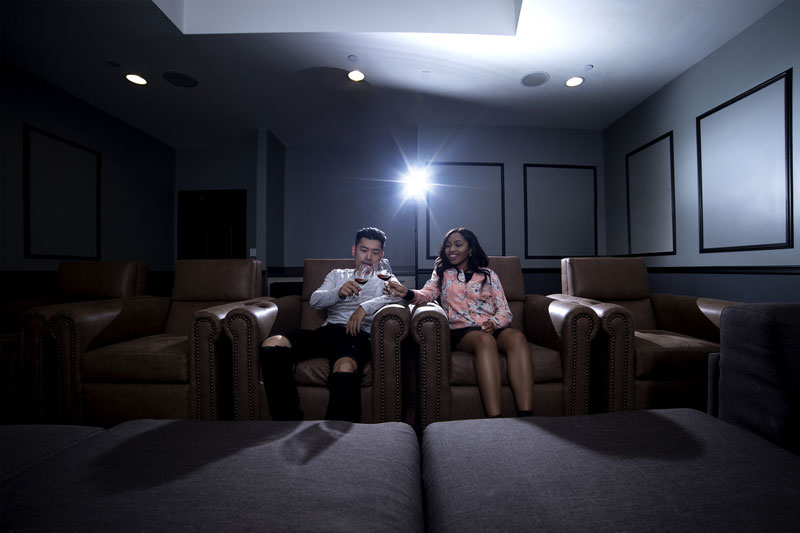
Building the Best Wireless Home Theater System – A Complete Guide
Did you know movie theaters don’t use reels of film to play movies anymore? There is no difference between the film quality at the movie theater and what you can have in your own home.
Thanks to digital projectors, streaming services, and high-quality wireless speakers there is no reason that you cannot have a genuine theater experience from the comfort of your home. With a little elbow grease, some know-how, and the right hardware your theater will rival the best.
Choosing a Location for your Home Theater
The location of your home theater should be out of the way and secluded. The further it is from a high-noise area, the less sound insulation padding you will need. Movies are no fun if you have to have the volume low, so make sure that it is somewhere that will not be bothersome to others in the house.
A room in the back of the basement is ideal for home theater systems. If you have a house that is built into a hillside, that’s even better. A room that is below the soil line of your house is perfect for home theaters.
Choose a room, or build a space, that is around 20 feet long by 13 to 15 feet wide. The smallest you should go is 12 feet by 12 feet.
If you are constructing the theater space from scratch, consider attaching it to your main living space or family room area. If you have two-story ceilings, consider lowering the ceiling to accommodate the theater above.
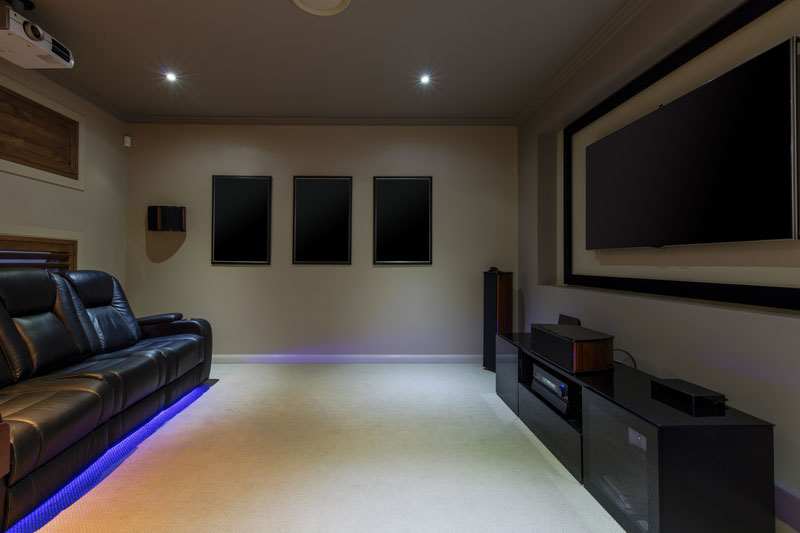
Choosing a Wireless Surround Sound System
All the best home entertainment systems feature an excellent surround sound system. The standard sound system size for a cinema-quality experience is 7.1.
7.1 surround sound systems include a subwoofer and seven channel speakers. The channels include one left, one right, two sides, and two rear speakers.
A wireless surround sound system is a lot easier to set up than a traditional wired system.
With wireless, you don’t have to run any cables or wires through the drywall to hide the unsightly connections. Just mount each speaker on your walls with wall anchors, and you’re ready to go.
Bluetooth surround sound speakers might be battery operated or rechargeable. But, the best wireless wifi surround sound speakers require a power source.
Even though they are “wireless”, they still need power.
The good thing is that you don’t have to run the speaker wires back to the amplifier. The audio signal from the amplifier transmits wirelessly, so you can have your amp receiver anywhere that’s convenient.
Install standard AC electrical outlets on the wall next to or just behind your surround sound speaker locations.
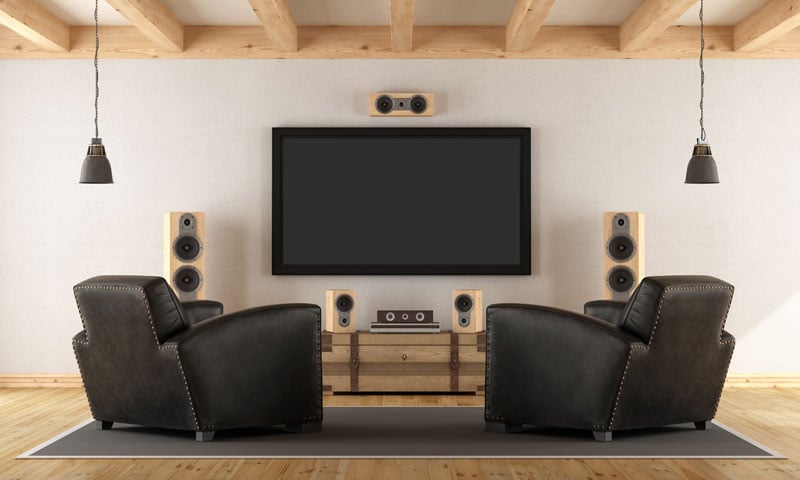
Placement for 7.1 Surround Sound Speakers
You don’t need the most expensive sound system to create a great cinematic experience. You just need to know how to place your surround sound speakers.
Your surround sound speaker placement must be tailored to the design of your home theater. But, no matter the design of your space, there are a few standard rules for how, and where to place the speakers of a surround sound system.
Center Speakers
For the center speakers, mount them above or below the screen area. There should be about an inch of space between the screen and the speakers for every 50 inches of screen size. For a 150-inch screen, mount the center speakers about three inches above or below the screen.
Left and Right Speakers
The left and right speakers go on either side of the screen. Mount them at ear height. Ear height is measured from a seated viewer’s position — not standing.
Side Speakers
The side surround speakers should be mounted on the side walls at ear height and centered to the seating area. The seating area starts with the front row of seats and ends with the back row-not the entire length of the room.
Rear Speakers
Placement for the rear surround sound speakers is measured according to the size, slope, and occupancy of the room.
Mount them on the wall directly behind the last row of seats. If the wall is close to the seats, position the speakers 6 to 12 inches above a viewer’s head height. If the wall is several feet from the last row of seating, mount the speakers at ear height.
If your seating rows are longer than four seats then mount the rear speakers one seat width apart, in the center of the back wall. Seating for five or more should have speakers centered to the end seats of the back row.
9.1 Surround Sound Speakers
If you have a 9.1 surround sound system, mount the extra two speakers on the top half of the wall next to your screen. They are meant to add aerial sound effects and other ambient noises, like birds, planes, noises from the attic-and so forth.
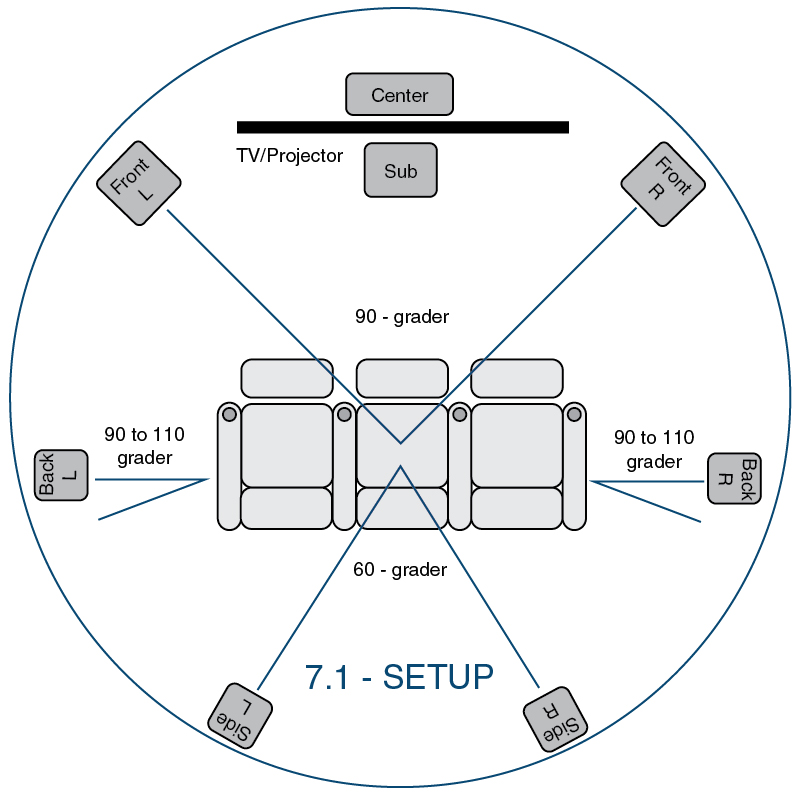
Wireless Surround Sound: Wifi vs. Bluetooth
Your surround sound system needs a method of transmitting and receiving a wireless signal, which is accomplished through a wifi or Bluetooth connection. The best wireless home theater systems are wifi enabled. Wifi provides the most stable transmission signal, as well as retains all of the digital audio signals quality.
Bluetooth surrounds sound systems are less reliable than wifi. They also condense the audio, which eliminates the hi-fi.
On the flip side, Bluetooth easily connects to any device, like smartphones and tablets. Without a control hub of some sort, like an Amazon Alexa or Google Home, wifi systems will not connect directly to devices.
A smart home hub enables you to connect your wifi sound system directly to your home theater system. So, Bluetooth is best for a budget home theater, while wifi is ideal for the best home theater systems.

Choosing the Best Wireless Video Projector
Home video projectors did not use to be nearly as high-quality as those available today. The market’s selection of home projectors went through a phase of substantial quality improvements in recent years.
The projection systems available on the market today rival any of the best cinemas and flat-screen TVs picture quality. The benefit of a wireless video projector is in pairing your computer, smartphone, tablet, or smart device without a cord.
The best wireless video projectors are equipped with a special, Mobile High-Definition (MHL) HDMI port. MHL lets you screen share high-definition video content from your Apple or Android device to your projector.
The best video projection technology is LCD, though it is also the most expensive. DLP produces high-quality video, as well.
Keep in mind when installing a projector screen, the optimal viewing angle is at 30 to 40 degrees-not flat on the wall. You want to see the clear color resolution when sitting.
It is important to size your screen appropriately to the size of your room and seating. Your seating space is essential in finding the ideal projection screen size. Place the front row of seats a distance of no less than 1.5 to 2.5 times the width of the screen.

Lighting Your Home Theater
The most atmospheric element to your viewing experience is your home theater’s lighting. Every movie theater has lighting for, both, transit in the theater and mobility while viewing. No theater gets pitch black.
Smart devices have revolutionized home theaters. Your home automation enables wireless, voice-activated control of your theater lighting.
But, smart-enabled home theater lighting has much more to offer. The Phillips Hue line of smart lights will work with your smart-enabled projector to produce synchronized effects with movies and music. So, when the Millenium Falcon goes into hyper-speed, your smart Hue lights flash, blink, and move with the movie.
Smart lighting comes in three categories: plug-in, wired, and bulbs. The easiest wireless method of lighting your homes theater with smart lights is with bulbs, like the Phillips Hue. Plug-in smart lighting is great for voice-activated light controls, but it doesn’t sync up with your viewable content.
Smart lighting opens the door to an entirely new dimension of home theater viewing. But, no matter what light bulbs you have, place them in recessed lighting. Track lighting looks clunky and obvious in a small home theater.
And don’t forget to install floor lighting that is recessed into the ground and on the edge of stairs. This will make sure that nobody trips and falls in the dark.
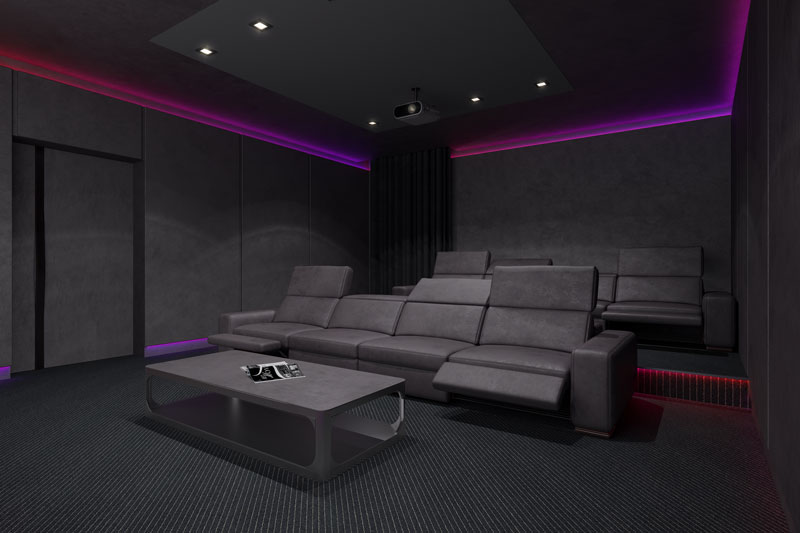
Choosing your Theaters Seats
Many homeowners are tempted to furnish their home theater with traditional couches and armchairs. But, this seating causes improper ergonomics for watching a large screen. The best home theaters are complete with theater-style seating.
Create a raised platform on which to place your seating. This allows for the most comfortable viewing. Seating that is made specifically for movie theaters features reclining backs, footrests, and built-in cup holders.
Not to mention you can get theater seating with wireless LED strip underglow lighting. Standard theater-style seating fits a row of four with ample space. In a 20-foot by 13 to 15-foot theater, a row of five seats will fit with narrow aisles on either side.
Keep in mind, that if you raise your seating area it will affect the correct speaker placement for your surround sound system. Raised seating also enables the best audio, since sound waves naturally carry upward.
If your home theater space is large enough, you might consider installing soundproofing tiles to dampen the rooms sound reverberation. Common carpeting is the DIY method, but professional sound insulation is the best option.
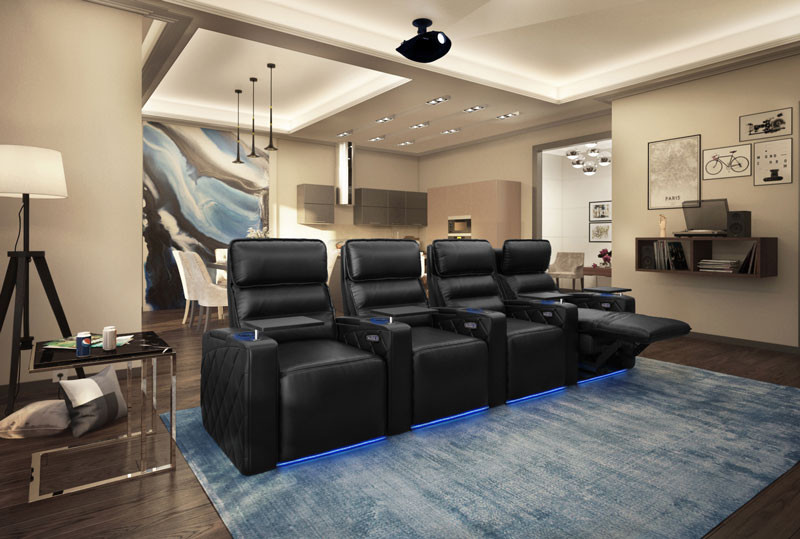
Final Thoughts
Building the best wireless home theater system takes planning. The best part of going wireless is the versatility of use it enables.
And, it saves you from running speaker cables through your walls. A wireless home theater certainly doesn’t signal the death toll for movie theaters, but it has forced them to up their game.
If you found this complete guide to building the best wireless home theater system helpful, share it with your friends and family on social media. And, don’t forget to subscribe to our newsletter to receive the most recent news and posts on the blog.

